How to choose the right holster

Most of us think long and hard about choosing a handgun because it's a big decision. Unfortunately, many choose a case after the fact.
It doesn't matter how good your gun is if you can't rely on it being well protected, easy to handle and quick to put into action.
The holster must be the right one for you, your carrying style and your weapon.
Discreet carry holsters
Holsters for concealed carry should not only hold your gun securely, they should also help you make it as discreet as possible.
This means that bulky flaps, padding and carrying systems are to be avoided; discreet leather is in fashion. There's also a limit to what a holster can do for concealment, and your choice of weapon is going to make a big difference.
If you go for a long-barreled, wide-frame revolver, your concealed carry options become very limited.
To learn more about this type of Holster, the Tact Store will meet your needs.
Holsters inside the waistband

Inside the waistband (IWB) holsters are the most popular option for concealed carry. These holsters attach to your belt with a loop or clip, and hold the gun inside your trouser waistband.
This is an excellent means of concealment, as only the stock and the rear of the slide are exposed above the belt. However, it's not the most comfortable style, and it exposes the weapon to perspiration.
They are best suited for compact and flat semi-automatics.
Holsters outside the belt
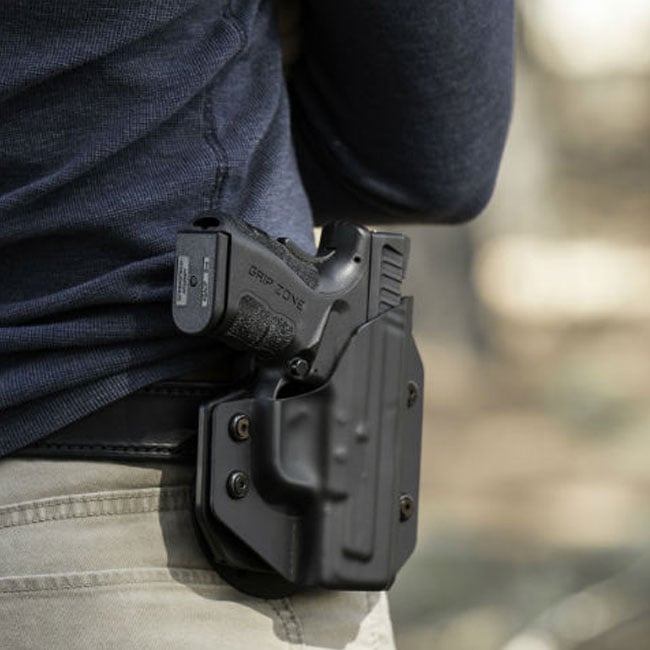
Off-Belt (OWB) holsters designed for concealed carry are a better option if you are carrying a larger revolver or semi-automatic.
These holsters often feature wide wings, which both keep the holster securely on the belt and smooth its shape, reducing the print on your shirt or coat.
shoulder holsters
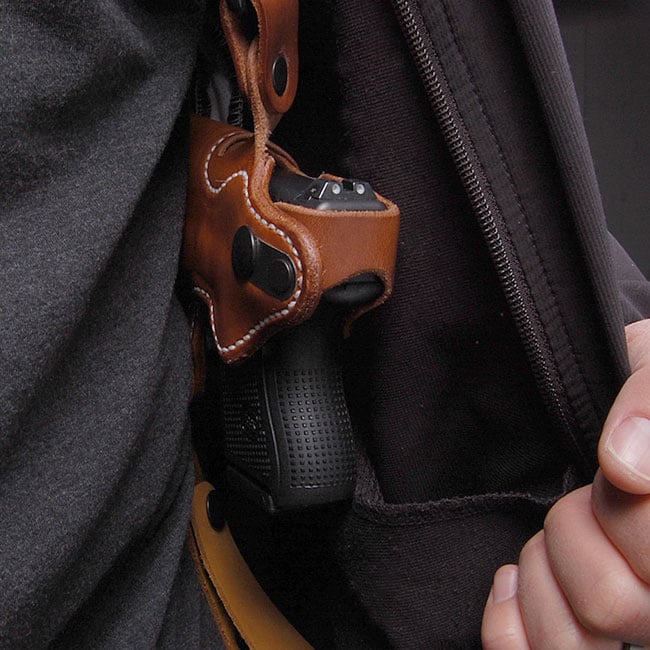
If you spend a lot of time in the car or sitting down, a belt holster can be uncomfortable - and unsheathing can be inconvenient too.
A shoulder holster is an excellent choice for comfort; the holster features loops on each shoulder, connected by a back strap, to help distribute the weight of the weapon.
Shoulder holsters are easily concealed under an open jacket and allow for quick unsheathing while seated. Many of them feature a magazine pouch located on the opposite side of the holster.
Another benefit of shoulder holsters is that they're the only really effective way to carry a large concealed revolver. The holster can be horizontal for compact pistols, making it easier to draw, or vertical for long barrel pistols.
Pocket cases

Sometimes it's easier to carry a gun in your pocket, but this can cause it to snag clothing or pocket contents, slow draw, or even accidentally trigger a bullet.
A pocket holster protects the weapon from snagging and allows you to draw cleanly when needed.
Most pocket holsters aren't fixed inside the pocket, making it quick and easy to move them from coat to coat - they rely on friction to hold them in place.
You will often find them with the rough side of the leather facing out, to give more friction against your pocket and less against your weapon.
ankle holsters
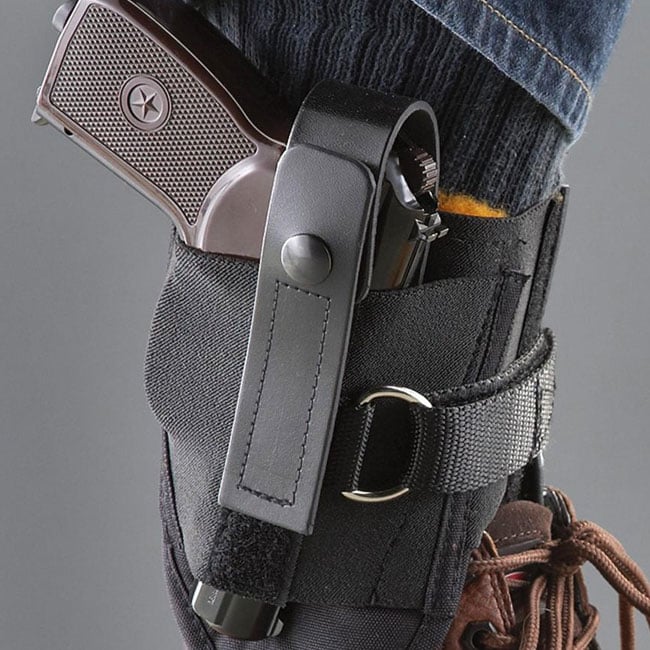
Ankle holsters are usually used for a backup weapon - either a subcompact semi-automatic pistol or a short-barreled revolver.
They allow the weapon to be concealed well and tend to go unnoticed during a hasty or surreptitious body search. They do, however, have a few drawbacks.
By the time you bend over and pull your pant leg up, the draw won't be the fastest in history.
They can also be uncomfortable if you do a lot of physical activity. Running around with a revolver bouncing against your ankle isn't much fun.
Holsters for waist belt

Designed to hide a handgun under a scruffy shirt, a belly holster is a wide elastic waistband with a built-in holster.
There are several styles that allow you to choose the exact location of the weapon - from just above the waistband to quite high on the chest.
Some are designed to hold the weapon in front of the body and others place it under the armpit.
Belly holsters are good for concealment, but bad for comfort. To hold the weapon firmly in place, they must be tight, making them uncomfortable to wear for long periods of time.
Visible port holsters
Belt Holsters
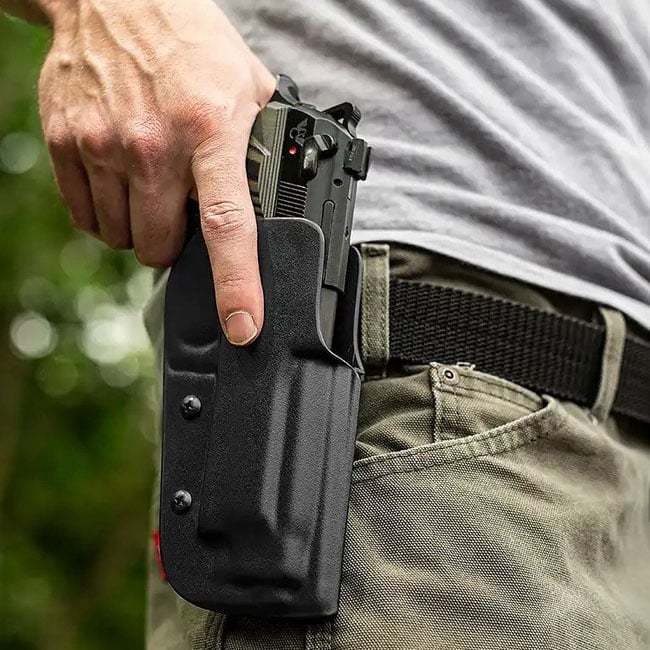
Belt holsters are the most popular choice for open carry, mainly because they are ideal for it. They keep the weapon out of reach but easily accessible.
They are secure and stay in position so when you reach for your gun you know exactly where it is.
Without the need to conceal the weapon, a belt holster can be much more comfortable, and you also get more retention options to keep the gun from slipping out of the holster until you want it to.
If you plan to carry your weapon openly, an open belt holster with a strap or other retention device is usually the best solution.
shoulder holsters
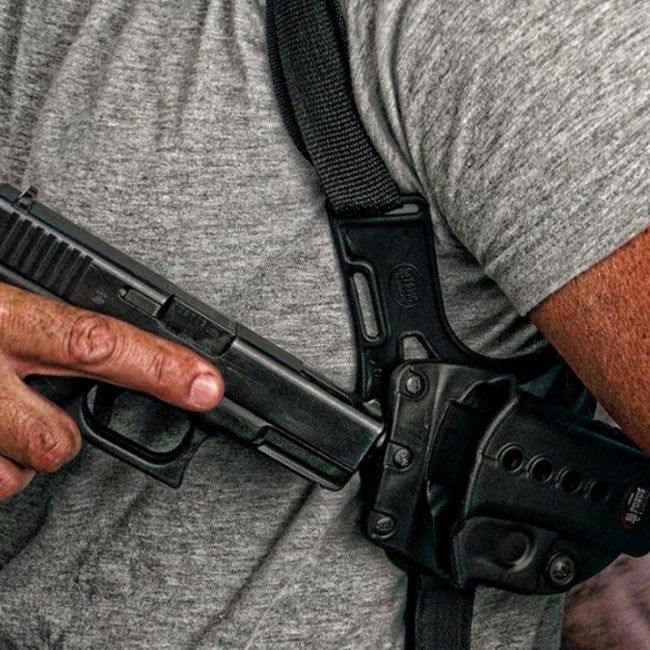
Sometimes, however, a belt holster is not ideal for open carry. Similar to concealed carry, if you spend a lot of time in the car or sitting down, it's best to use a shoulder holster.
When it comes to shoulder holsters, the same holsters are generally suitable for both concealed carry and open carry. The main difference with open wear is that you don't have to worry about wearing a jacket over it.
If you're smaller, you can also get away with a larger pistol - unless you have some mass to vanish against, a 1911 will never be well concealed.
Service and tactical holsters
Belt Holsters
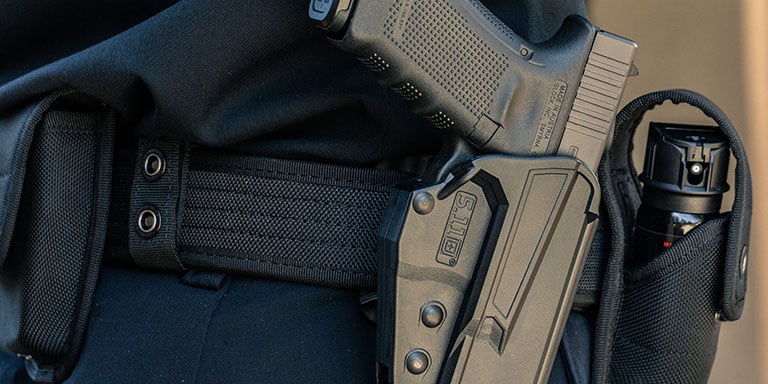
Belt holsters are the traditional military and police solution. An equipment belt or strap is an ideal support for a holster, and keeps all your equipment in one unit.
Police belt holsters usually have an open top and some sort of retention. This allows for quick unsheathing and with modern retention devices there is little chance of someone else getting hold of the weapon.
Military belt holsters are a bit different. For soldiers, a quick draw is desirable, but less important than for a police officer - few soldiers carry a handgun as their primary weapon, usually senior officers or non-combat specialists. Military handguns, however, have a tough life.
They are worn for long periods in dirty, muddy, wet, dusty or cold conditions. Protection is therefore a priority, and most holsters are full-flap models that cover as much of the weapon as possible.
thigh holsters
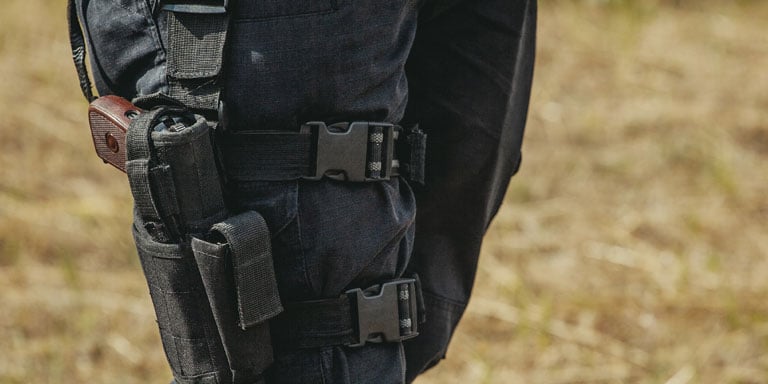
Belt holsters are great, but they can be tricky to use, especially if you're seated. If you drop your hand to the side, it's a good twenty centimeters from the butt of a gun holstered in your belt.
Practice helps, but a drop-leg holster is — in theory, at least — a more intuitive way to do it.
Drop leg holsters hang from your mid-thigh waistband, and a strap around the thigh secures them in place. Extension kits convert most military belt holsters to drop lug holsters.
Kits usually contain a thigh board with a PALS grid and attached support straps. One of their big advantages is that they work well with body armor long enough to interfere with a belt holster. Learn more about body armor basics.
Drop-leg cases are controversial. Some find them easier to use, while others say they are more awkward in certain positions. Shooters who have trained with belt holsters for years may find it difficult to adapt.
Drop leg holsters also don't hold the weapon as firmly as a belt style, so they tend to bounce around when you run. When you're on all fours, the case can slip under your thigh and be dragged through the dirt.
shoulder holsters
A shoulder holster doesn't work well with a full combat load - it becomes very difficult to unsheath it when you have to stretch around armor loaded with pockets.
For troops operating with lighter gear, on the other hand, they offer the same advantages as open carry - the weight is evenly distributed and it is easy to draw while seated or in the car.
You should know that a shoulder holster worn on a uniform is quite obvious and can therefore be interpreted as aggressive in certain situations.
Chest holsters
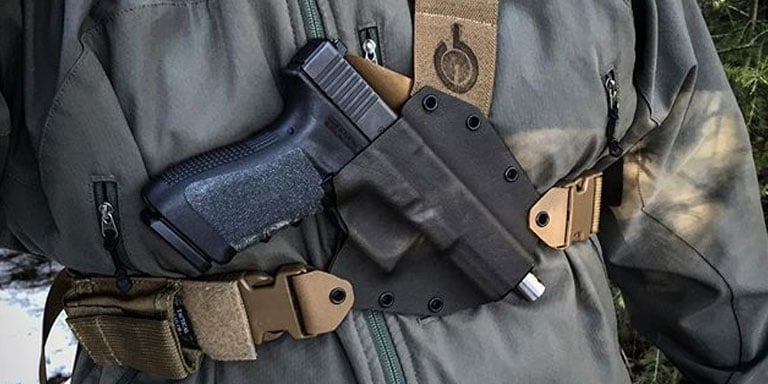
An alternative to shoulder holsters that works well with armor is a chest holster. They usually attach to the PALS grid of any MOLLE compatible armor.
Positioned so that the butt of the weapon is above your sternum, they make firing quite easy. If you are a driver or crew member of a vehicle, they are a good option.
Case Materials
Leather
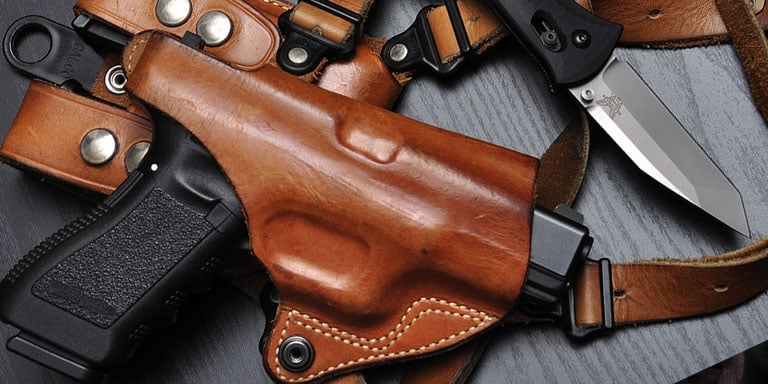
Leather is the traditional case material, and it is still popular today. Leather is durable, versatile and aesthetic. Modern leather holsters range from traditional styles to molded and reinforced holsters designed to fit a specific model of gun.
Leather is an excellent choice for concealed wear. It is flexible, and with wear it molds to both the body and the weapon. A good leather case doesn't add a lot of bulk, which makes it easier to conceal.
There are, however, drawbacks. Leather requires a lot of maintenance. Improperly cared for leather can absorb moisture from rain or sweat, and you really don't want to see wet leather surrounding your handgun all day. It also accumulates scratches and gouges, which will not damage the function of the case but deteriorate its appearance.
Leather also tends to soften and wrinkle as it ages, which can be dangerous. Many people have used a pistol in an old leather that bent, got into the trigger guard and fired a bullet.
Kydex
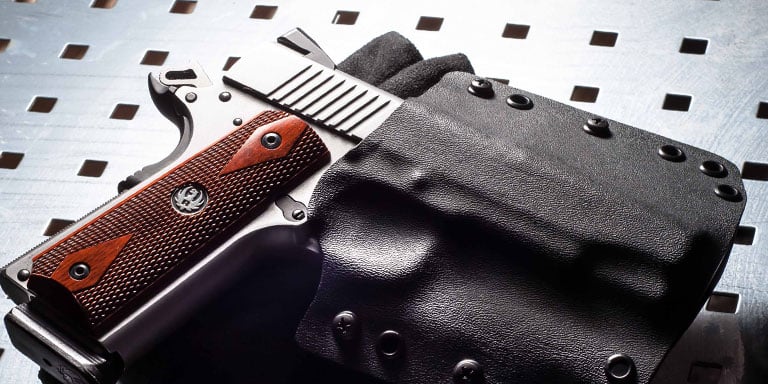
Kydex and other hard plastics are great materials for holsters. They are tough, can be molded into any shape, and actually protect the gun. Their rigidity also makes them ideal for cases with retention systems. They are usually designed for a specific weapon.
The main disadvantage of rigid plastic is that it is often uncomfortable for concealed wear. It doesn't mold to your body like leather does. Hard cases also tend to be bulkier and more visible.
These materials are low maintenance and do not absorb water, sweat or dirt. Even if they are covered in mud, they can be easily cleaned.
Synthetic holster
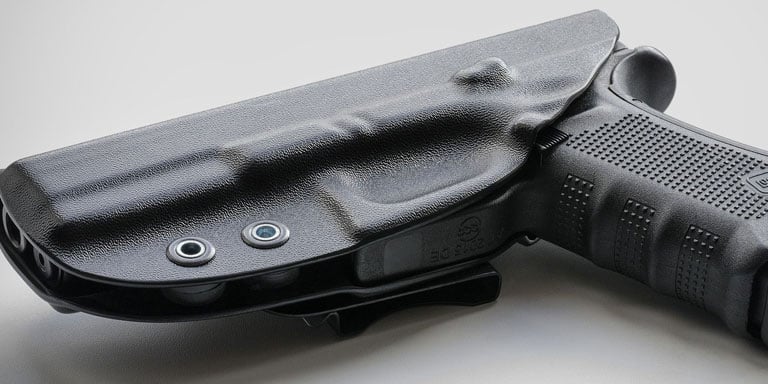
Many synthetic fabrics have been used to make holsters. Synthetic fabrics are (usually) durable and low maintenance. Their other properties place them somewhere between leather and Kydex.
A solidly made nylon holster is quite bulky, so it is not very suitable for concealed carry. They are also harder to clean than Kydex. They are generally more waterproof than leather and protect the weapon well.
These holsters are also more forgiving of slightly different weapons than they were specifically designed for. This is useful if you don't always carry the same model of gun. Finally, they can be more comfortable than Kydex because they are less rigid and offer some padding. Buy Synthetic Fabric Holsters
Retention methods
Your weapon is therefore in the case. Now you need to make sure it stays there until you want it out - but when you want to hold it in your hand, it needs to be able to get there quickly. There are a variety of retention methods to achieve this.
Friction

Many cases do not have a separate retention system; they simply rely on the friction between the weapon and the holster to keep it in place.
Most concealed carry holsters fall into this category. For everyday use, it works well.
No one should try to pick up a concealed weapon (they won't know you have it, because it's concealed) and you probably won't run too much, so a well-made, well-maintained, well-fitting holster to your gun should hold it in place well.
Many modern holsters feature a retention screw that can be adjusted to change the degree of friction - and the security of holding the weapon.
Flaps

Most traditional military holsters feature a flap that covers the butt of the gun and holds it in place. These models are very effective in preventing your weapon from falling, and they also protect it from rain, dust and mud.
The downside is that they are slower to use, since you have to open the flap and get your hands on the weapon. Flip cases are great for field use, but a poor choice for everyday civilian wear.
straps
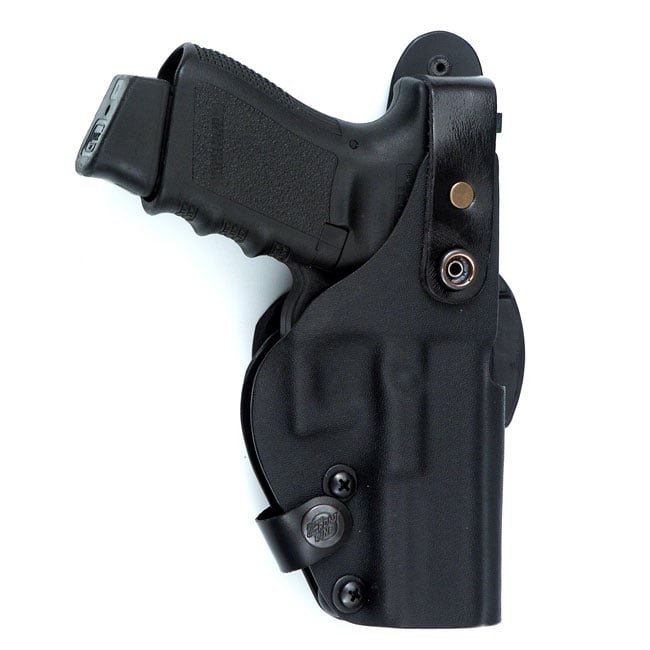
If you don't need to protect your gun from the elements for weeks, a thumb-breaking strap is a better alternative to the flap. The straps fitted to most traditional police and open carry holsters can be released very quickly.
However, while they protect your weapon from being dropped, they do little to prevent someone from catching it - they can release the sling as easily as you can. Thumb loops - which usually go over the hammer - are similar to straps, but have no attachment.
Trigger guard locks

A more modern solution found on many Ridgid holsters, especially those intended for law enforcement, trigger guard locks feature a hook or rod that locks into the gun's trigger guard.
To unlock it, you must press a button or other device on the outside of the case. It usually doesn't take a rocket scientist to figure out these devices, but if someone tries to grab your gun, they won't be able to do it quickly.
Retention Levels
Cases are generally categorized by level of retention. A higher level means it's harder for someone to holster your weapon without your cooperation - but it also means your draw will be slower, so more retention isn't always better.
Which level is best for you depends on what you're wielding your weapon for. If you're a police officer or civilian who carries their gun openly, someone trying to holster your gun is a real concern. If you are a soldier, a flap that prevents the weapon from falling should usually suffice.
Description
Tier 1 retention
Level 1 relies on friction to hold the weapon in place. A well-fitting Level 1 holster, especially one with a retention screw, is secure enough to hold your gun in place during most activities - but it won't prevent someone else from shooting it. take. Most concealed carry holsters are level 1.
Tier 2 retention
Level 2 has a second retention method in addition to friction. A strap is the most common option, but trigger guard locks are growing in popularity.
Tier 3 retention
Level 3 has two additional retention methods besides friction. This is usually a strap and a trigger guard lock. Many police departments specify level 3 for duty cases.
Level 4 retention
Level 4 has three methods of retention, plus friction. Level 4 cases are extremely safe; it's nearly impossible for anyone to pull the gun out if you don't cooperate.
There is no better case. Which one is right for you depends on a lot of things.
Before you buy, you need to know exactly what you need. Once you've figured this out, you can narrow the scope down considerably.
The final choice may take a little work, but the rewards are worth it.
If you make the right choice, you will have equipment that will protect your weapon and ensure that it is where you need it, when you need it.
0 comments